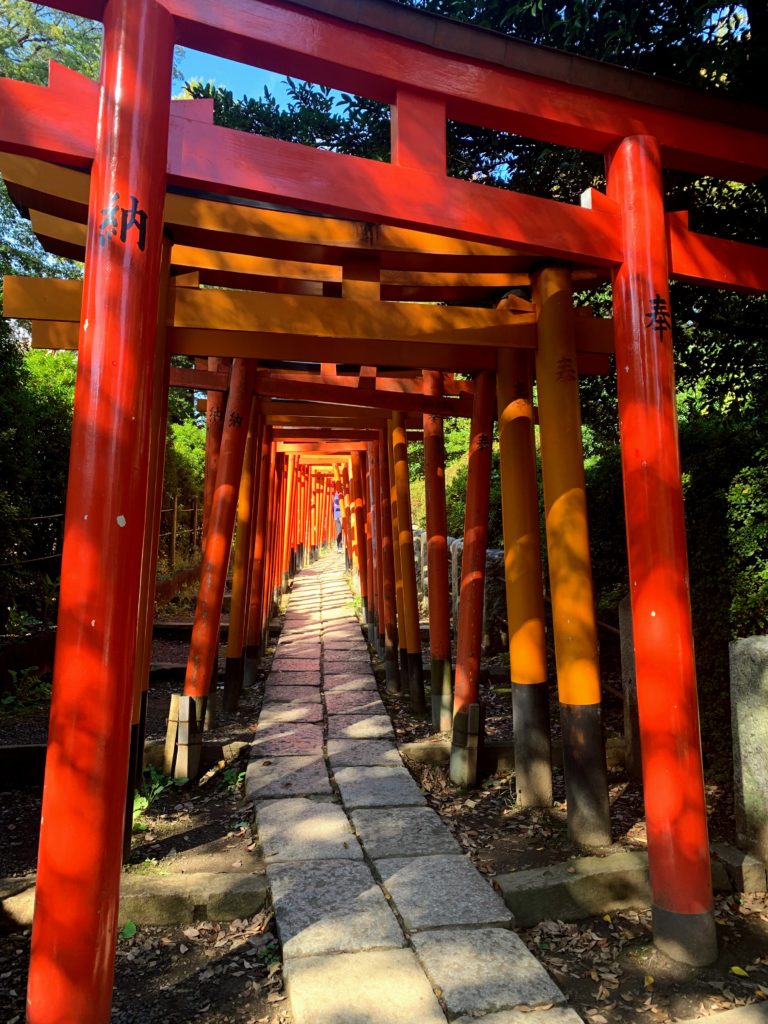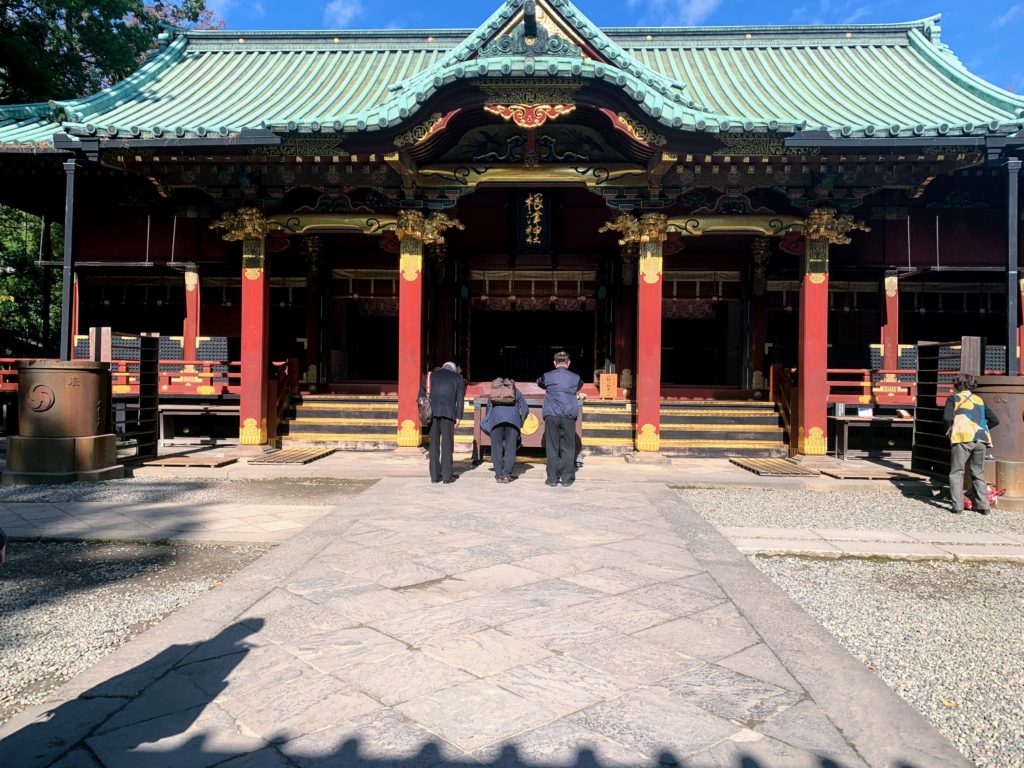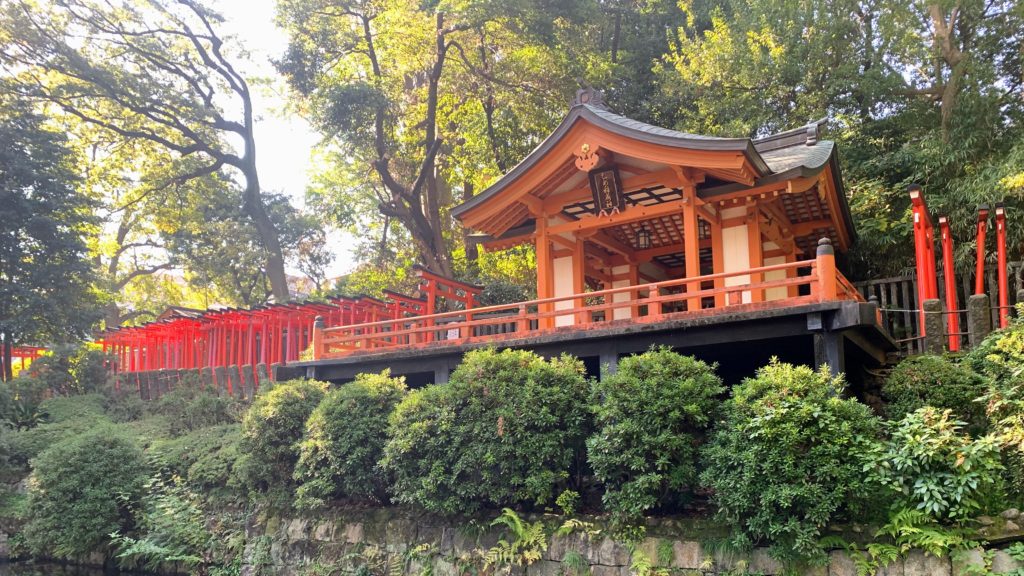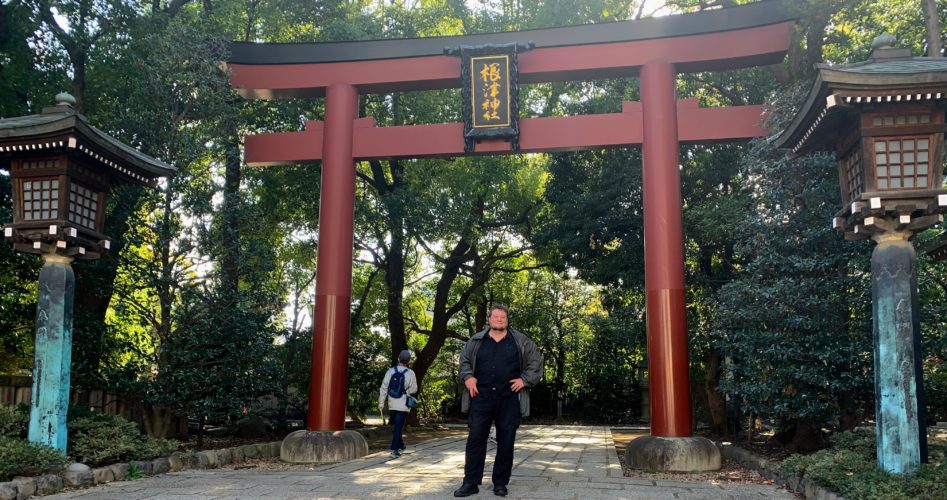Nezu Shrine (根津神社 – Nezu-
Since Nezu Shrine is a mere 15-minute walk from where Sig and I were staying, we made it one of our first stops after setting foot in Tokyo.
Tunnel of Torii
From the busy street, the area looks like a simple park, until we wandered deeper into one of the three entrance paths. According to Shinto belief, a tori entrance indicates a transition between the mundane to the sacred.
Although the looming Torii main gate did impress me, I found the path of a hundred or so vermilion torii beautiful — something about repeating patterns feels comforting. This torii tunnel leads me through the hillside just west of the main hall.
Stooping slightly as not to hit my head, the steps took me to a viewing platform with a small shrine and pavilion. From here I could see the main shrine and a koi-filled pond below. Nearby, a cozy Otome Inari Shrine sits guarded by two fox statues.
Otome means “maiden,” and the Inari is the god or spirit of foxes, fertility, rice, tea, sake, and anything agriculture related. I was told that newly wedded ladies often pray here for a good marriage. I’m hardly a maiden, but I did drop a customary five yen coin into the box and make a quick wish.

Tower Gate
We make our way down the hill through a shorter path of torii, and then through a rōmon (楼門). Beneath this two-story tower gate, two zuishin or guardian statues sit in alcoves, ready with their bows and arrows. I guess if the shrine came under attack, the warrior-gods would spring to life and ascend the tower to rain arrows upon the enemy.
Court Yard & Lattice Wall
Before we reach the Main Hall, we crossed beneath an embellished karamon (唐門 – Chinese gate) and into a courtyard surrounded by a sukibei (透塀 – latticed wall). Against a sacred camphor tree, lines upon lines of paper fortunes tied to strings swing lightly in the wind. Dozens of small wooden plaques hang in hopeful anticipation of the new year. As we approached the offering box, I noticed two large Komainu or “lion dogs” guarding the shrine, each with a fierce stony gaze.
Main Hall
Also called a honden in Japanese, Nezu’s main hall is ornately designed with golden embossing along its lintels and pillars. Even the steps leading up and into the chamber seem to shimmer. I peek inside the worship hall and see a wall-to-wall tatami floor and a shrine in the back. I am awe-struck that this beautiful structure survived the firebomb attacks during World War II.
According to nearby kiosks, Nezu shrine itself is built in the Ishi-no-ma-zukuri (石の間造) style, where the worship chamber (拝殿 – haiden) and the inner sanctum (本殿 – honden) are connected under a single roof. If you’re wondering, the haiden is where people gather, and service is held. The honden is off limits to the public since this is where the enshrined kami lives, customarily signified by a mirror or statue.

The Legend
Although not officially captured in historical texts, legends say that Nezu shrine was founded in Sendagi during the 1st century by Prince Ōsu (also known as Yamato Takeru), son of Emperor Keikō. At that time, the shrine was dedicated to Susanoo-no-Mikoto, the god of the sea and storms. If this legend were proven to be true, it would date Nezu Shrine as the oldest Shinto shrine in Tokyo.
But in full disclosure, nothing of that 1st-century shrine remains. The Nezu Shrine we see today comes from Tokugawa Tsunayoshi, the fifth shogun of the Tokugawa dynasty. The shogun moved and entirely rebuilt Nezu Shrine in its current location, and what he kept or didn’t keep from the original shrine is hard to say. However, historical records do state that Tsunayoshi undertook the move of Nezu Shrine in 1705 in a successor-naming celebration.
Nezu Shrine Bunkyo Azalea Festival
Every April, the hills to the west of the Torri tunnel comes alive with thousands of Azalia blossoms from over a hundred different varieties. Amid the colorful blooms, performers and food stalls delight any and all. With the various azalea breeds, the blooming can last a well into May or later, resulting in one of Tokyo’s longest running festivals during the spring season.
I should note that Nezu Shrine for much of the year is free to the public, but during the Azalea Festival you have to pay a small fee of ¥200


